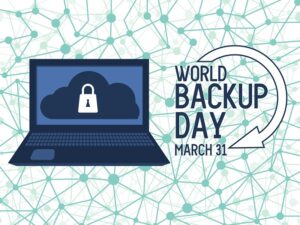
( Bukharina Anna/Shutterstock)
As far as vacations go, World Backup Day does not produce the enjoyment of Christmas or Halloween. There is no mascot, such as a “Backup Bunny” (sorry, Easter), nor any imbibing of adult drinks, as on St. Patrick’s Day and Cinco de Mayo (most likely an advantage). However March 31 is the one day of the year when information experts can stop and think about, for one shining minute, why backups are so essential.
The crossway in between security and backups is well trod area, as cyber bad guys posture among the best threats to valuable, valuable information. When you think about that 98% of companies have actually suffered a cyberattack in the previous year, according to Rubrik‘s State of Data Security report, then it actually drives house the value of having a strong backup strategy.
” If your company is relying exclusively on tradition backup services to recuperate from a cyber occurrence, you’re exposing your crucial apps and information to considerable threat,” states Anneka Gupta, Rubrik’s primary item officer. “While numerous companies have backup services in location, this tradition innovation alone is inadequate to efficiently prevent today’s advanced cyber danger landscape. A more holistic technique is required that integrates backup and healing with information security to supply cyber resiliency.”
Sadly, backups themselves are targets of cyber bad guys. Research studies programs that 94% of backup repositories were targeted in a ransomware attacks, according to Scality CMO Paul Speciale.
” With increased ransomware hazards and the popular attacks occurring continuously, backup has actually handled increased value,” Speciale states. “Simply having backups isn’t adequate any longer; companies require a strong backup security method … World Backup Day is a suggestion of the value of buying a scalable and immutable system that supplies fast brings back, such as those provided by contemporary item storage services.”
As information volumes and cyber attacks grow, companies have actually pertained to understand that backups are mission-critical work, states Neil Jones, director of cybersecurity ministration at Egnyte Nevertheless, not all backups are equivalent.
” The most considerable advancement I have actually seen over the previous numerous years is that the majority of business can no longer see information backup method monolithically,” Jones states. “Rather, they require to stabilize a fully grown Service Connection and Catastrophe Healing (BCDR) program with lighter, more active backup methods such as photo healing. Here’s why:
” In case of a considerable, just-in-time cyber-incident like a ransomware attack, users can not stay efficient without instant access to their information, and even minutes or hours of information disturbance can have a significant effect on efficiency,” he states.
So what else can companies do to protect their systems and reinforce their backups? Upgrading tradition innovations is an excellent primary step, states Paul Martini, CEO of iboss
” To satisfy contemporary cyber hazards, companies require effective services that can match the elegance of these foes,” Martini informs us. “Business need to think about changing their tradition innovations like virtual personal networks [VPNs], proxies, and virtual desktop facilities [VDIs] with a single zero-trust network gain access to service. This will guarantee they much better safe and secure information long past World Backup Day.”
The crucial nature of backups suggests companies need to appoint obligation for keeping backups and catastrophe healing (DR) preparedness to several workers, states Jason Konzak, senior vice president of expert services at Flexential
” Every day, an appointed worker ought to by hand evaluate backup and DR task successes, and failures,” he states. “Stopped working tasks require to be tracked as occurrences and remedied so they do not end up being relentless spaces in secured information. Likewise, designated employee need to check backups and DR services, record the outcomes not just of success and failure, however likewise record the anticipated healing time and healing points (RTO and RPO). The outcomes of these tests need to be shown organizational management so everybody can be on the exact same page about the capability of IT to secure crucial information and keep organization operations running.”
A big migration of information to the cloud has actually occurred over the previous couple of years. If companies aren’t cautious, that can journey them up when it pertains to their backup methods, states Norman Kromberg, the CISO for NetSPI
” There are a number of crucial errors companies make when it pertains to handling information backups,” Kromberg informs us. “The very first is not upgrading as a company moves to brand-new innovation. For instance, moving from on-prem to the cloud might alter application and information structure. As an outcome, if a company needs to recuperate systems, the backups might not match the production systems.”
The backup itself has actually gotten the lion’s share of attention. However George Axberg III, vice president of the information security department at VAST Data, motivates companies to consider backup’s close cousin: information healing.
” Information security operations has actually constantly concentrated on moving information by means of a backup rapidly, while brings back were viewed as a secondary, however required task,” Axberg states. “Instantaneous healing is absolutely nothing brand-new– bring back 10 to 20 virtual devices (VMs) immediately has actually been supported for several years. However with the huge inflection in information accumulation/sprawl over the last couple of years, how can companies immediately bring back countless VMs, disorganized file systems, and 20+ TB databases? Organizations today need to be prepared not simply for backup and healing, however for immediate gain access to and immediate operations at business scale.”
Not all information is equivalent, and not all information requires to be supported. Giant information lakes with 10s of petabytes, for instance, can not be effectively supported (however information lakes currently include internal redundancy, such as erasure encoding, so a different backup is generally unneeded). That’s a crucial reality that numerous companies neglect, states Adam Rusho, the field CTO for Clumio
” Numerous aspects that can add to increasing AWS backup expenses consist of the inaccurate understanding that all information is crucial enough to require a backup, utilizing the exact same backup method for all information, little presence into backups and copies, absence of granularity in existing backup services, and needing to develop extra vaulted copies,” Rusho states.
” To prevent such mistakes, business need to make the effort to find and expunge unneeded copies and backups and fine-tune backup methods by getting an understanding of underlying information,” he states. “It likewise suggests that business should not be forced to secure whatever … Rather, utilize an information discovery tool that enables you to check out element folders and things, and wisely appoint policies.”
The dish to secure information is basic, according to Tyler Moffitt, a senior security expert at OpenText Cybersecurity: You simply require to establish a backup method, test your backups, keep backups offsite, secure your backups, and execute a backup tracking system. Easy, right?
Not so quickly. Obviously, there’s a bit more to each of these actions. Moffitt enthusiastically completes the broad summary with some relevant information:
Establish a backup method: “Start by evaluating what information requires to be supported and how regularly,” Moffitt states. “Think about the kind of information, its value, and the effect of losing it. Then, choose the backup area and technique, such as cloud-based, physical backup, or a mix of both. I suggest the latter, however I can comprehend if spending plans remain in the method. That is likewise a main reason SMBs are targeted.”
Evaluate your backups: “It’s necessary to check your backups routinely to guarantee they’re working properly. Test backup information to make certain it can be recuperated and is functional,” he states. “Without these dry-run practice sessions, your backups might be ineffective or lead to your group associating their hair on fire throughout a time of crisis when you require to be calm and gathered.”
Keep backups offsite: “If you keep your backups onsite, they might be susceptible to theft, fire, or natural catastrophes,” Moffitt includes. “For that reason, keeping backups offsite also in a safe area is advised. Cloud-based backup services use this choice to supplement any onsite service.”
Secure your backups: “It is very important to secure your backups to avoid unapproved access to the information,” he states. “File encryption makes sure that even if somebody gains access to the backup information, they will not have the ability to read it or utilize it for take advantage of on a leakage website in information exfiltration cases, which are all too typical.”
Execute a backup tracking system: “A backup tracking system assists you track your backups and guarantees they’re running properly,” he concludes. “It signals you if there are any concerns, such as stopped working backups or inadequate storage area. Having pictures and a running history of variations of files is vital also. In case any of the most current variations were to end up being jeopardized, you can have copies that you understand will bring back properly.”
Here’s hoping you have a delighted (and uneventful) rest of World Backup Day.
Associated Products:
Improving Backup Resiliency as the Last Line of Ransomware Defense
Crafting a Hybrid Cloud Backup Method
Supporting Big Data? Opportunities Are You’re Doing It Incorrect



